
Barbecue or barbeque is a term used with significant regional and national variations to describe various cooking methods which use live fire and smoke to cook the food. The term is also generally applied to the devices associated with those methods, the broader cuisines that these methods produce, and the meals or gatherings at which this style of food is cooked and served. The cooking methods associated with barbecuing vary significantly but most involve outdoor cooking.

Teppanyaki, also incorrectly known in some countries as hibachi, is a post–World War II style of Japanese cuisine that uses an iron griddle to cook food. The word teppanyaki is derived from teppan, the metal plate on which it is cooked, and yaki, which means grilled, broiled, or pan-fried. In Japan, teppanyaki refers to dishes cooked using a teppan, including steak, shrimp, okonomiyaki, yakisoba and monjayaki.
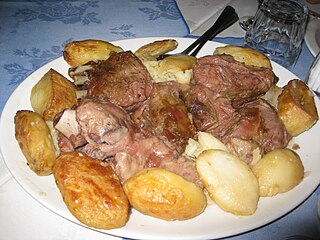
Lamb, hogget, and mutton, generically sheep meat, are the meat of domestic sheep, Ovis aries. A sheep in its first year is a lamb and its meat is also lamb. The meat from sheep in their second year is hogget. Older sheep meat is mutton. Generally, "hogget" and "sheep meat" are not used by consumers outside New Zealand, South Africa and Australia. Hogget is becoming increasingly commonly eaten in England, particularly in the North often in association with rare breed and organic farming.
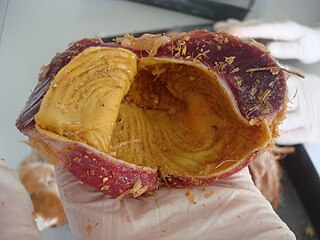
The gizzard, also referred to as the ventriculus, gastric mill, and gigerium, is an organ found in the digestive tract of some animals, including archosaurs, earthworms, some gastropods, some fish, and some crustaceans. This specialized stomach constructed of thick muscular walls is used for grinding up food, often aided by particles of stone or grit. In certain insects and molluscs, the gizzard features chitinous plates or teeth.

Kebab is a cooked meat dish, with its origins in Middle Eastern cuisines. Many variants are popular around the world.

Churrasco is the Portuguese and Spanish name for beef or grilled meat more generally. It is a prominent feature in the cuisine of Brazil, Uruguay and Argentina. The related term churrascaria is mostly understood to be a steakhouse.

Barbecue varies by the type of meat, sauce, rub, or other flavorings used, the point in barbecuing at which they are added, the role smoke plays, the equipment and fuel used, cooking temperature, and cooking time.

Mongolian beef is a dish from Taiwan consisting of sliced beef, typically flank steak, usually made with onions. The beef is commonly paired with scallions or mixed vegetables and is often not spicy. The dish is often served over steamed rice, or in the US, over crispy fried cellophane noodles. It is a staple dish of American Chinese restaurants. Despite its name, the dish has nothing to do with Mongolian cuisine.
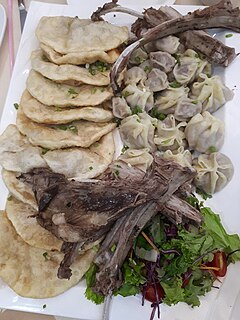
Mongolian cuisine predominantly consists of dairy products, meat, and animal fats. The most common rural dish is cooked mutton. In the city, steamed dumplings filled with meat—"buuz"— are popular.

Kabsa is a mixed rice dish, served on a communal platter, that originates from Saudi Arabia but is commonly regarded as a national dish in countries of the Arabian peninsula.
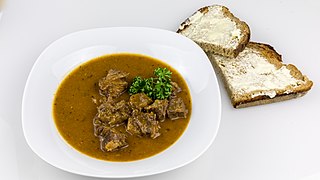
Oxtail soup is a soup made with beef tails. The use of the word "ox" in this context is a legacy of nomenclature; no specialized stock of beef animals are used and tails may come from bovines other than oxen. It is believed by some that oxtail soup was invented in Spitalfields in London in the seventeenth century by French Huguenot and Flemish immigrants, from the tails of animals. Different versions of oxtail soup exist: Korean; Chinese; a fried/barbecued oxtail combined with soup variation which is a popular dish in Indonesia where it is called as sop buntut; an ethnic dish of the American South which traces its lineage back to the pre-revolutionary war era; and a thick, rich, gravy-like soup popular in the United Kingdom since the 18th century. Creole oxtail soup is made from a tomato base with oxtails, potatoes, green beans, corn, mirepoix, garlic, and herbs and spices.

Mongolian barbecue is a stir fried dish that was developed by Wu Zhaonan in Taiwan in 1951. Meat and vegetables are cooked on large, round, solid iron griddles at temperatures of up to 300 °C (572 °F). Despite its name, the dish is not Mongolian, and is only loosely related to barbecue.

The Tarbagan marmot is a species of rodent in the family Sciuridae. It is found in China, northern and western Mongolia, and Russia. In the Mongolian Altai the range overlaps with that of the Gray marmot. The species was classified as endangered by the IUCN in 2008.
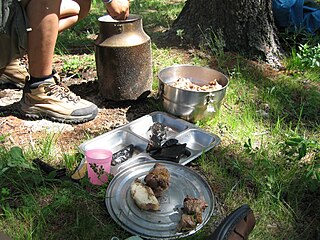
Khorkhog is a barbecue dish in Mongolian cuisine. Khorkhog is made by cooking pieces of meat inside a container which also contains hot stones and water, and is often also heated from the outside.

Korean barbecue refers to the popular method in Korean cuisine of grilling meat, typically beef, pork or chicken. Such dishes are often prepared on gas or charcoal grills built into the dining table itself. Some Korean restaurants that do not have built-in grills provide customers with portable stoves for diners to use at their tables. Alternatively, a chef uses a centrally displayed grill to prepare dishes to order.

Texan cuisine is the food associated with the Southern U.S. state of Texas, including its native Southwestern cuisine influenced Tex-Mex foods. Texas is a large state, and its cuisine has been influenced by a wide range of cultures, including Southern, German, Czech, British, African American, Creole/Cajun, Mexican, New Mexican, Native American, Asian, Jewish, and Italian.

The cuisines of Oceania include those found on Australia, New Zealand, and New Guinea, and also cuisines from many other islands or island groups throughout Oceania.

















